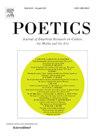规则网:使用关联规则和网络图映射文化偏好的结构
IF 1.7
2区 社会学
0 LITERATURE
引用次数: 0
摘要
社会学家有说服力地认为,文化意义可以通过分析衡量所谓文化材料“结合在一起”的关系系统来解释。调查文化品味和偏好的研究使用这种方法将消费模式解释为关系系统,使用多种技术,包括多维尺度、双模式网络分析和变量相关网络。我通过描述和演示一种在社会学中很少使用的数据挖掘技术(称为“关联规则”)的使用,为这一不断增长的工具集做出了贡献。这种技术的关键贡献在于,它在变量之间产生了直接的关系(例如,对歌剧的偏好→对芭蕾舞的偏好),与现有的将相互存在的关系概念化的技术相比,它有几个优势。我展示了这种“单边”聚类(A与B相结合,但B可能不与A相结合)是如何用网络图来表示和分析的,我将这种方法称为“Rulenet”。我讨论了所提出的技术如何为品味组织提供相对新颖的见解,通过其他技术不太可行,并在美国两个著名的文化参与调查数据集上说明了Rulenet:(1) 2017年的公众参与艺术调查(SPPA)和(2)1993年的一般社会调查文化模块(GSS)。本文章由计算机程序翻译,如有差异,请以英文原文为准。
Rulenet: Mapping the structure of cultural preferences using association-rules and network graphs
Sociologists have persuasively argued that cultural meaning can be interpreted by analyzing the systems of relations that measure the so-called ‘going together’ of cultural materials. Research investigating cultural tastes and preferences has used this approach to interpret consumption patterns as relational systems using a variety of techniques including multidimensional scaling, two-mode network analysis, and variable correlation networks. I contribute to this growing set of tools by describing and demonstrating the use of a datamining technique with scant history of use within sociology, called ‘association-rules.’ The key contribution of this technique is that it generates directed relationships between variables (e.g., preference for opera → preference for ballet), which has several advantages over existing techniques that conceptualize relationality in terms of mutual presence. I show how such ‘one-sided’ clustering (A goes with B, but B may not go together with A) can be represented and analyzed as network graphs, an approach I call ‘Rulenet.’ I discuss how the proposed technique can provide relatively novel insights into the organizations of tastes, less feasible via other techniques, and illustrate Rulenet on two well-known cultural participation survey datasets for the United States: (1) The Survey of Public Participation in the Arts (SPPA) from 2017 and (2) The General Social Survey Culture Module from 1993 (GSS).
求助全文
通过发布文献求助,成功后即可免费获取论文全文。
去求助
来源期刊

Poetics
Multiple-
CiteScore
4.00
自引率
16.00%
发文量
77
期刊介绍:
Poetics is an interdisciplinary journal of theoretical and empirical research on culture, the media and the arts. Particularly welcome are papers that make an original contribution to the major disciplines - sociology, psychology, media and communication studies, and economics - within which promising lines of research on culture, media and the arts have been developed.
 求助内容:
求助内容: 应助结果提醒方式:
应助结果提醒方式:


